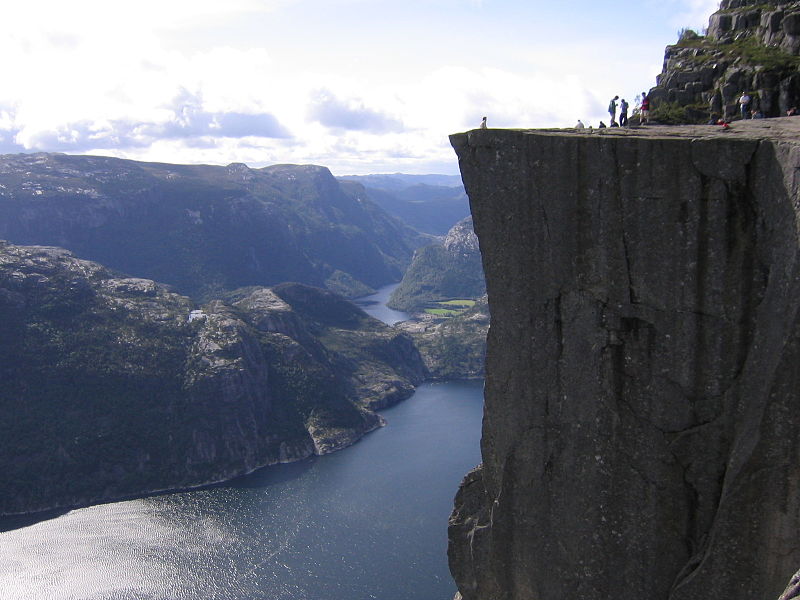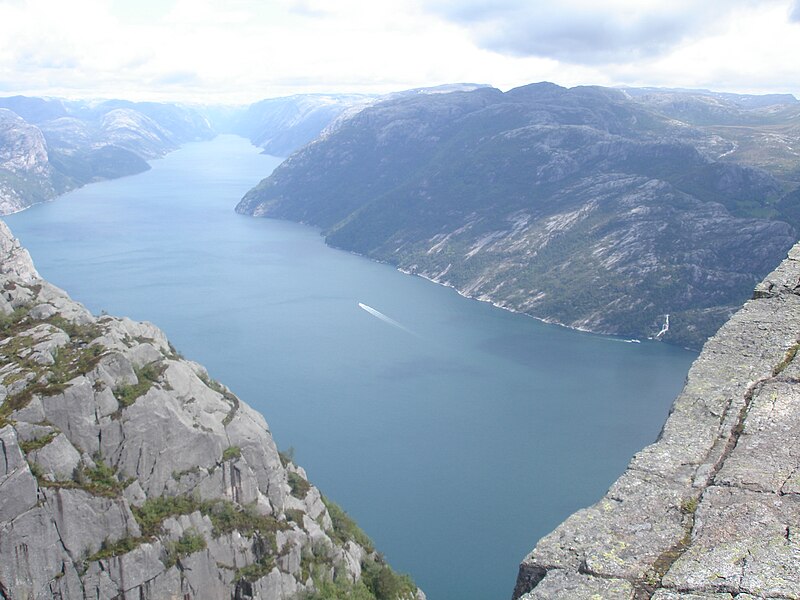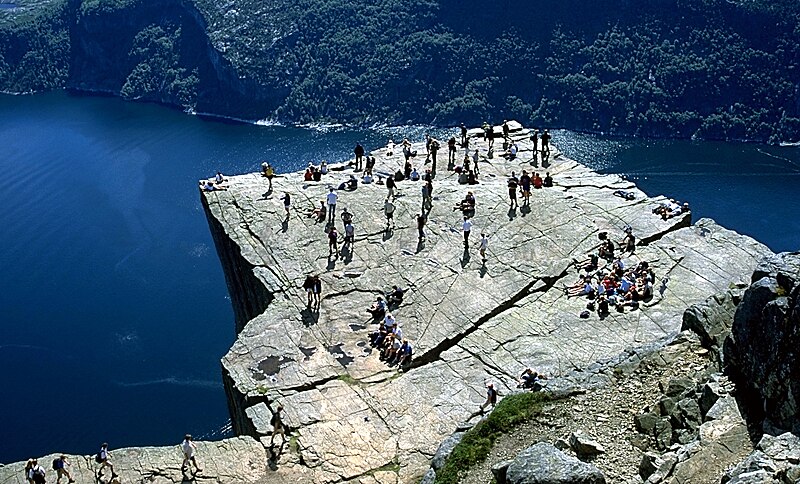Preikestolen or Prekestolen, also known by the English translations of Preacher's Pulpit or Pulpit Rock, and by the old local name Hyvlatonnå (“the carpenter-plane’s blade”), is a massive cliff 604 metres (1982 feet) above Lysefjorden, opposite the Kjerag plateau, in Forsand, Ryfylke, Norway. The top of the cliff is approximately 25 by 25 metres (82 by 82 feet), almost flat, and is a famous tourist attraction in Norway.
The tourism at the site has been increasing, around 2012, the plateau was each year visited by between 150,000 and 200,000 people who took the 3.8 km (2.4 mi.) hike to Preikestolen, making it one of the most visited natural tourist attractions in Norway.

Access
The Pulpit Rock is located in Ryfylke, Rogaland, a county in Western Norway. The city of Stavanger, the fourth largest in Norway, is located only 25 kilometers from the site, and the parking facility of the Pulpit Rock is located about one hour from Stavanger by ferry and car.
The road to the site ends at a parking facility at Preikestolen Fjellstue. A trail extends from the parking facility to the site, which goes through a variety of mountain landscapes. A trip to Preikestolen from the closest car park takes about 3-4 hours for a round-trip hike.
The walk to Preikestolen is very steep in places. The path starts at the Preikestolhytta, at an elevation of approximately 270 metres (886 feet) above sea level, and climbs to 604 metres (1982 feet). The hike takes 1-3 hours depending on experience and fitness level. Even though the elevation differential is only 334 metres (1096 feet) and the walk is not particularly long (3.8 km each way), the total elevation gain and loss over the course of the hike is more than one might initially expect, as the path climbs and descends various ridges.
The walk is not recommended in winter and spring when there is snow and ice, and the track may be slippery. Best season to hike the trail is from April to October. Sturdy shoes and rain gear are recommended for the hike.
An alternative to the site is available year round: a ferry trip sails beneath the Pulpit rock through the Lysefjord. The weather other than in the summer can be wet and cold, and clouds can then prevent seeing the rock. The ship stops at several small docks on the way in & out, including a layover at the end of the Lysefjord
Safety
In 2006 alone, 90,000 people visited Preikestolen during the four summer months. Nevertheless, to this day no safety railing has been constructed on the edge of the cliff so as not to harm the natural beauty of the cliff. Despite the insecure gorge, there have been no accidents at the site, but there have been suicides and suicide attempts. In February 2000, an Austrian woman and a Norwegian man committed a joint suicide by jumping together off the cliff after meeting on the internet and forming a suicide pact. In October 2004, a young German couple were on their way to the cliff to commit suicide but were stopped in time by the Norwegian authorities
One thing that does happen every year though is hikers injuring themselves on the journey to or from the plateau, and many have had to be brought back due to a sprained ankle.
Formation
The cliff was formed during the Ice age, about approximately 10,000 years ago, when the edges of the glacier reached the cliff. The water from the glacier froze in the crevices of the mountain and eventually broke off large, angular blocks, which were later carried away with the glacier. This is the cause of the angular shape of the plateau. Along the plateau itself there continues to be a deep crack. The cracks show that the plateau will at some point fall down, but all the geological investigations have revealed that this event will not happen in the forseeable future, and the geologists have thus confirmed the safety of the plateau.
Climate
Along the fjord there is a mild and humid coastal climate.
Surrounding landscape
The cliff overlooks the densely and colorful green valleys of the Ryfylke region. The mountains surrounding the cliff reach heights of up to 843 meters. Some of the hilltops have plains which are interspersed with lakes.
The nearby mountain Kjerag (which reaches the height of 1,110 meters, near the bottom of the Lysefjord) is also a very popular hiking destination, and some actually rather go there due to the increasing popularity Preikestolen has gained, which has led to it becoming more crowded in comparison to Kjerag.
Trivia
A granite sculpture of the cliff was erected in the town Langeskov in Denmark to commemorate its twin town Forsand.
Gallery

Preikestolen

View from Preikestolen, Lysefjorden below

Panoramic view from Preikestolen on Lysefjorden

Preikestolen, June 2009

On top of Preikestolen, June 2009

Preikestolen and surrounding area

View of Preikestolen in B&W
No comments:
Post a Comment